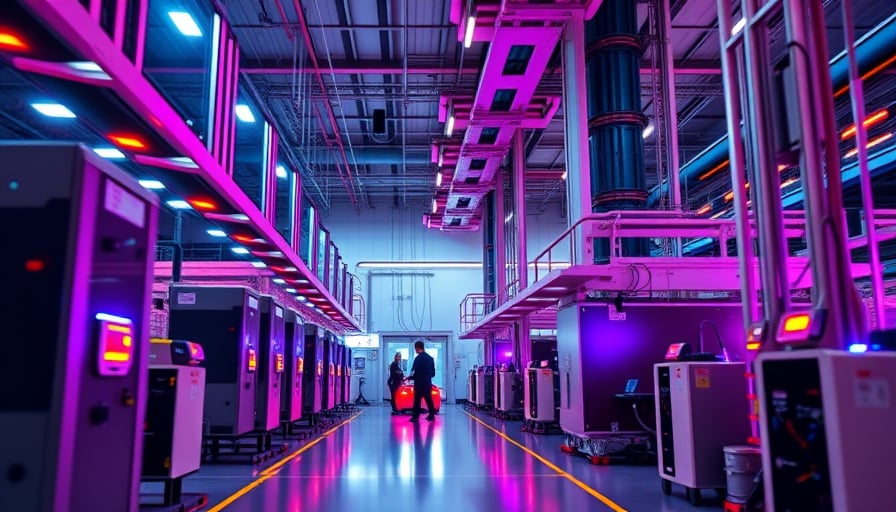Microsoft Launches First AI Superfactory to Accelerate Cloud and AI Profitability
Microsoft Corporation today unveiled its inaugural AI superfactory—an expansive, distributed network of data centers designed to lower capital expenditures and enhance margin performance for the company’s cloud and artificial‑intelligence (AI) businesses. The announcement, made at the company’s Ignite 2025 event, details the integration of sites in Wisconsin and Atlanta, which will serve as core hubs for training large‑scale machine‑learning models and running inference workloads.
Technical Overview
The superfactory concept leverages edge‑centric architecture to reduce data movement latency and energy consumption. By colocating GPU‑enriched compute clusters with high‑bandwidth storage systems, Microsoft aims to:
| Feature | Description | Expected Impact |
|---|---|---|
| Distributed Data Centers | Multiple facilities strategically positioned to balance load and fault tolerance | Decreases operational risk and improves service uptime |
| Low‑Latency Fabric | 10‑gigabit optical links interconnecting clusters | Enables real‑time inference for high‑frequency trading and autonomous systems |
| Energy‑Efficient Cooling | Liquid cooling loops and AI‑optimized airflow management | Cuts power usage effectiveness (PUE) by up to 15 % |
| Scalable Workloads | Modular GPU racks that can be re‑configured for different model sizes | Supports rapid experimentation with next‑generation transformers |
The architecture is intended to support Microsoft’s Azure AI platform, which powers services ranging from natural‑language processing to computer vision. By consolidating compute resources, Microsoft anticipates a reduction in capital expenditure per teraflop of performance, thereby improving profitability for its cloud and AI segments.
Industry Context
According to a 2023 Gartner report, AI‑driven infrastructure investments are expected to grow at a compound annual rate of 12 % through 2028. Analysts note that companies who can lower the cost of training large models will capture a larger share of the high‑margin AI services market. In this light, Microsoft’s superfactory aligns with industry trends toward hyper‑efficient data center designs and edge computing.
Investment analysts at Morgan Stanley and Bloomberg have highlighted the long‑term margin expansion potential. Morgan Stanley’s senior analyst, Dr. Elena Garcia, stated, “The distributed superfactory model positions Microsoft to reduce the cost per model training cycle by 18–22 % relative to traditional monolithic data centers. This translates into a measurable uplift in the Azure AI margin, which historically averages around 40 %.”
Gaming Segment Performance
Microsoft’s Xbox Series X/S lineup reported robust sales figures, with a 14 % year‑over‑year increase in units shipped. The company also launched a new AAA title, “Starfall Odyssey,” which received favorable reviews across major platforms. However, Microsoft’s stock experienced a slight decline following the expansion of its Xbox Cloud Gaming service (xCloud). The service now supports streaming to Android phones, iOS tablets, and smart TVs without a dedicated console.
The expansion is intended to deepen Microsoft’s penetration in the cloud‑gaming ecosystem, a sector projected to reach $20 billion by 2027 (IDC). By widening device compatibility, Microsoft aims to increase the active user base, thereby boosting subscription revenue through its Game Pass Ultimate offering.
Industry experts caution that the incremental cost of streaming infrastructure may offset short‑term gains. “While expanding cloud gaming enhances market reach, the associated bandwidth and content delivery costs can strain margins unless offset by higher subscription uptake,” notes Game Analytics’ chief data officer, Maya Patel.
Regional Tax Policy Concerns
Microsoft executives have publicly expressed apprehension regarding proposed progressive tax reforms in Washington state. The company warns that heightened corporate tax rates could erode job security and deter future investment in the region’s technology sector. Microsoft’s CFO, Amy Hood, remarked at a recent investor call, “The current fiscal climate poses significant uncertainty for our growth plans in the Pacific Northwest.”
The commentary has sparked dialogue among investors and policymakers. A Washington state legislative review panel is slated to convene in early 2026 to assess the impact of the tax proposals on high‑growth tech firms. Analysts suggest that a balance between fiscal reform and job protection is essential to maintain the region’s competitive edge.
Financial Stability and Market Position
Microsoft’s market capitalization remains one of the largest in the technology industry, hovering above $2.2 trillion as of the latest trading session. The company’s consolidated earnings for the most recent quarter surpassed analyst expectations, driven largely by growth in Azure revenue and the newly launched AI services.
While the company’s strategic investments in AI infrastructure and cloud gaming continue to attract investor interest, analysts remain vigilant about external factors such as regional tax policy. As of Q4 2025, Microsoft’s free‑cash‑flow margin stood at 38 %, underscoring its robust financial footing.
Takeaway for IT Decision‑Makers
- AI Infrastructure: Consider partnering with Microsoft’s Azure AI platform to leverage the cost efficiencies of the new superfactory, particularly for training large transformer models.
- Cloud Gaming: Evaluate the business case for integrating Xbox Cloud Gaming into your content delivery strategy, taking into account bandwidth costs and subscription dynamics.
- Tax Considerations: Monitor state‑level tax developments that could influence regional investment decisions, especially if your organization operates in or plans to expand into Washington state.
By aligning technology strategy with Microsoft’s evolving infrastructure and market positioning, IT professionals can capitalize on emerging opportunities while mitigating operational risks.




